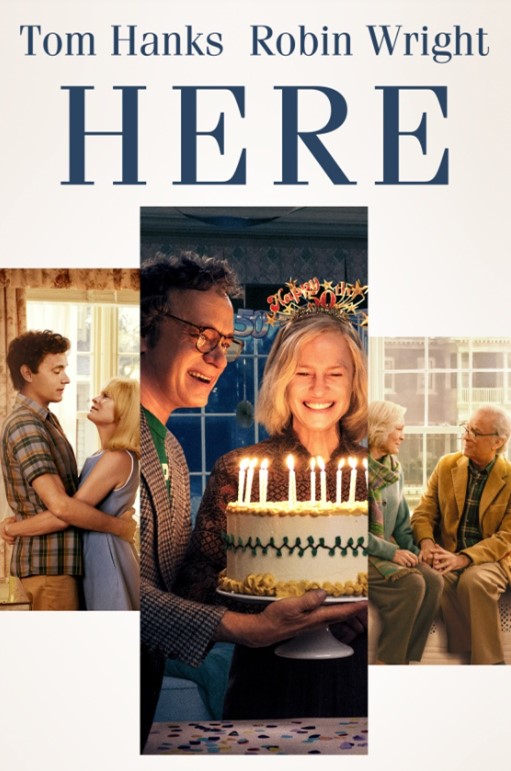Here
Here, 2024, 2 ¼ stars
Here neither here nor there
 Exclusive to MeierMovies, January 30, 2025
Exclusive to MeierMovies, January 30, 2025
“Years go falling in the fading light. Time passages. … I know you’re in there; you’re just out of sight.”
I don’t know whether Robert Zemeckis is a fan of Al Stewart’s song, but the lyrics mimic the legendary writer-producer-director’s new experimental film, Here. Change “passages” to “rooms,” and you have a logline for the movie, which the boundary-pushing filmmaker co-write with Forrest Gump collaborator Eric Roth (based upon a graphic novel by Richard McGuire).
Like the song, the film is filled with fascinating ideas and the best premise of any 2024 movie. But thanks to heavy-handed dialogue, ham-fisted directing, on-the-nose messaging and overly broad acting, it’s one of the most disappointing movies of the year, and of Zemeckis’s illustrious career.
Here is the story of a single plot of land over millions of years, from the dinosaurs to today. And, astonishingly, we, the audience, observe the story from a fixed “camera” position. The land, buildings, characters and styles change, but our observational, voyeuristic position doesn’t (except for some intercut “snapshots” that add visual variety). “Camera” is in quotes because, predictably, Zemeckis, ever the experimenter, relies heavily on CGI, meaning there was no camera at all for several scenes. He also employs some of the most realistic de-aging technology for the actors – specifically Tom Hanks and Robin Wright (in another Gump reunion) – ever created, though “created” is an odd word because Zemeckis apparently relied extensively on AI. Morality aside, it is a technical triumph.
The film is structured in a non-linear way, jumping frenetically back and forth from the Mesozoic Era, to pre-Colonial scenes of Native Americans, to Benjamin Franklin (whose son, in one of the movie’s many contrived moments, just happened to live in a house near the film’s focal point).
But the film centers not on those eras but on several vignettes of the 20th and 21st centuries. We witness the construction of the house that becomes the film’s focus, around the turn of the last century. That’s followed chronologically by a World War I-era mini-plot featuring actress Michelle Dockery (Downton Abbey). Don’t blink or you’ll miss an odd escapade featuring a bohemian couple from the early 1940s. That gives way to the father (Paul Bettany) and mother (Kelly Reilly) of Hanks’ character, who purchase the home just after World War II.
The rest of the tale mostly involves the Hanks and Wright characters, though we do briefly meet the Black family who bought it from them, which allows Zemeckis to sandwich in racial issues, along with a COVID-19 reference, which was probably meant to book-end a Spanish Flu sub-plot from 1919. But we never spend enough meaningful moments with anyone to truly feel the emotional sweep of time, until perhaps the very end, when Zemeckis reaches deep into his bag of tricks and plucks out an overdue magical moment, punctuated by the music of another Gump alumnus: Alan Silvestri.
Despite that fitting finale, this project is better suited to a theme park. If you cut the 104 minutes down to 30, shot the film in 3-D and projected it on a Cinerama screen, you’d have a fine time-travel-themed attraction. But as a theatrically released picture, it lacks subtlety and character development, and is ultimately reduced to a special-effects gimmick. It is time wasted.
“There’s something back here that you left behind, oh, time passages.”
© 2025 MeierMovies, LLC
For more information about this movie, visit IMDB and Wikipedia. The film is currently streaming.